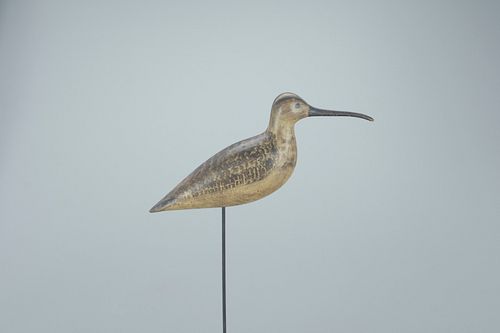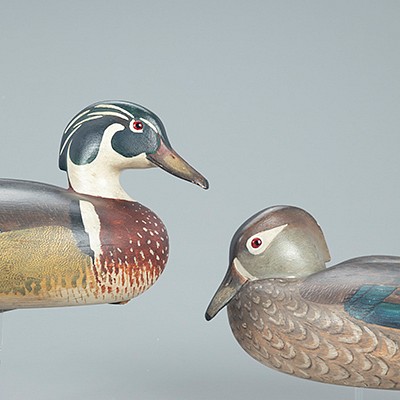The Purnell-O'Brien Shourds "Green Rig" Curlew Decoy, Harry V. Shourds (1861-1920)
About Seller
20 Winter Street
Pembroke, MA 02359
United States
Founded in 2005, Copley Fine Art Auctions is a boutique auction house specializing in antique decoys and American, sporting, and wildlife paintings. Over the course of the last two decades, the firm has set auction records for not only individual decoy makers, but also entire carving regions. Copley...Read more
Two ways to bid:
- Leave a max absentee bid and the platform will bid on your behalf up to your maximum bid during the live auction.
- Bid live during the auction and your bids will be submitted real-time to the auctioneer.
Bid Increments
| Price | Bid Increment |
|---|---|
| $0 | $50 |
| $1,000 | $100 |
| $2,500 | $250 |
| $5,000 | $500 |
| $10,000 | $1,000 |
| $25,000 | $2,500 |
| $50,000 | $5,000 |
About Auction
Mar 4, 2022
Lots 1-264 Copley Fine Art Auctions cinnie@copleyart.com
- Lot Description
The Purnell-O'Brien Shourds "Green Rig" Curlew
Harry V. Shourds (1861-1920)
Tuckerton, NJ, c. 1890
13 3/4 in. long
Harry Vinuckson Shourds is not only the most well-known decoy maker from New Jersey, he is also one of the earliest. In addition to being one of the few professional carvers of his generation, Shourds hunted ducks for market while his wife used the feathers to make pillows and bedding.
An exemplary Shourds “green rig” shorebird decoy, described as such because of its hue. This curlew displays painted eyes, a splined bill, and exceptional blended feathering. This curlew is one of the finest examples by this maker known to exist. The underside retains the Purnell Collection’s “P” brand along with the stamp that denotes the Donal C. O'Brien Jr. Collection.
The larger size of both the body and bill of this carving, in comparison with the following curlew, lot 103, suggests that Shourds may have made representations of both the larger long-billed curlew and the smaller whimbrel.
In original paint with even gunning wear, very minor touch-up to lower left flank and left side of head.
Provenance: William H. Purnell Jr. Collection
Donal C. O'Brien Jr. Collection
Private Collection, Florida
Literature: Richard A. Bourne Co. Inc., "Very Rare and Important American Bird Decoys, From the Collection of the late William J. Mackey, Jr. of Belford, New Jersey," Boston, MA, 1973, Session IV, lot 123, rigmate illustrated. Peter Johnson and Alf Wannenburgh, “The World of Shooting,” Lausanne, Switzerland, 1987, pp. 259-261, exact decoy illustrated. Copley Fine Art Auctions, "The Donal C. O'Brien, Jr. Collection of Important American Sporting Art and Decoys, Sessions I-II," Hingham, MA, 2017, front inside boards of hard-cover edition, pp. 138-143, lots 68-75, exact decoy in O'Brien Shourds rig illustrated.Please email condition report requests to colin@copleyart.com. Any condition statement given is a courtesy to customers, Copley will not be held responsible for any errors or omissions. The absence of a condition statement does not imply that the lot is in perfect condition.Condition
- Shipping Info
-
Copley Fine Art Auctions does not handle the shipping of any items. Shipping is the sole responsibility of the buyer. Once your payment has cleared, and we have received your authorized shipping release form items may be released for shipment. Copley Fine Art Auctions, LLC shall have no liability for any loss or damage to such items. Buyers should allow up to four weeks for shipment.
-



 EUR
EUR CAD
CAD AUD
AUD GBP
GBP MXN
MXN HKD
HKD CNY
CNY MYR
MYR SEK
SEK SGD
SGD CHF
CHF THB
THB














